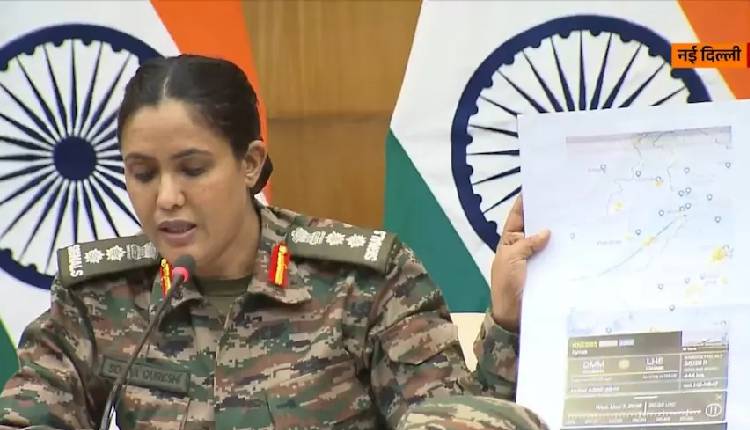New Delhi: “As tensions mounted post Operation Sindoor in India, Pakistan brazenly left its airspace shield of its territory by flying a swarm of drones against India,” Indian military sources said. Colonel Sofia Qureshi disclosed on May 9, that civilian flights operated over Pakistan, including the Dammam-Lahore route, on May 8–9, when ground armies were heavily engaged. On the contrary, India on restraint mode safely handled civilian aircraft landings during the attack. The Indian armed forces also thwarted Pakistani infiltration attempts, killing 300–400 Turkish-made drones and countering artillery fire directed across the Line of Control (LoC).
Pakistan’s Irresponsibility Over Afghan Civilian Airspace
At a press briefing observed by many as being held in the style of its wartime predecessor, the Ministry of Information (April 27) had Colonel Sofia Qureshi, along with Foreign Secretary Vikram Misri and Wing Commander Vyomika Singh, lay out Pakistan’s audacious aggression and complete disregard for the safety of civilians as a nation the day before. Qureshi revealed that Pakistan kept open its airspace when Saudi Arabia took a massive drone attack; even flights continued from the main cities like Karachi and Lahore. In spite of these hostilities, she showed evidence of a civilian flight from Dammam. This flight flew out at 5:50 p.m. on May 8 and landed in Lahore at 9:10 p.m.
Qureshi said that Pakistan concealed itself behind civilian aircraft and sacrificed innocent passengers”, which could have resulted in a disaster. India, in opposition, had announced a ban in its airspace for domestic traffic, thereby posing no threat to civil aerial vehicles. The Indian Air Force showed exceptional restraint, managing the safe landing of civilian international aircraft and steering clear of any action which could put lives at risk. This was done by maintaining international aviation safety regulations.
Targeted Drone Offensive and LoC violations
On 8-9 May, according to Colonel Qureshi, Pakistan flew 300–400 Turkish-made drones from 36 locations along the LoC and international border towards Indian military infrastructure within India. Asisguard Songar UAVs – Ground Station In a thwarted infiltration attempt, drones identified as Asisguard Songar UAVs were neutralised with India’s S-400 air defence system and Integrated Counter-UAS Grid neutralising the threats. The Indian Army responded in a highly disciplined manner, striking a balance between minimising collateral damage and effectively addressing the incursion.
Besides the drone strikes, Pakistan started increasing ceasefire violations by using heavy mortars and armed drones in Jammu and Kashmir sectors Tangdhar, Uri, Poonch, Mendhar, Rajouri, Akhnoor and Udhampur. Many Indian soldiers injured in these attacks, but the losses thrown at Pakistani forces in response have also been severe. Qureshi stated that the Indian army has disciplined mortars that balance diplomacy with defence and people.
Context of Operation Sindoor
Moreover, the Pakistani offensive was a counter to India’s Operation Sindoor, which took place on May 6–7, 2025. This involved the destruction of operational terrorist infrastructure in Pakistan and Pakistan-occupied Kashmir, in which more than 100 terrorists were killed. The operation crippled Pakistan’s air defence systems, including HQ-9 units made in China. This was in retaliation for the Pahalgam terror attack on April 22, 2025, which killed 26 people. The drone offensive, the LoC violations — Pakistan undertook this sequence of attacks to probe Indian defences and shock the Indian psyche into shock and awe, sullying India’s image and making her look reluctant to respond, mired in a swamp of civilisational indifference and betrayal, and mired in a civilisational quagmire of her own making and a victim of her own unprecedented failure in accepting the menace of radical Islam — Pakistan, enraged by these setbacks, counterattacked in ways seen above.
India has hit out at Pakistan after the latter continued flights for civilians as the airspace here detonated with tension. It accused its neighbour of unnecessarily complicating its operations. In contrast, India minimised non-combatants’ risk by closing its airspace and carefully managing civilian flights.
Proof and international matters
Qureshi brought photos and flight data disclosing the route of the Dammam-to-Lahore flight, its timing, and other particulars to expose how Pakistan had been acting irresponsibly. These images expose Pakistan’s negligence about civil life again and could have resulted in an international aviation incident if India had not exercised restraint here. The briefing was intended to highlight the grave threat to international peace that the Pakistani strategy of destroying civilian infrastructure to protect military capabilities presents.
The incident has also heightened tensions between India and Pakistan, with the former accusing the latter of breaching international protocols and putting civilians in jeopardy. With the successful neutralisation of the drone attack and India reacting in a measured fashion, India lacks no responsibility as a player in the international system. This is even though tensions continue to escalate.



Comments are closed.